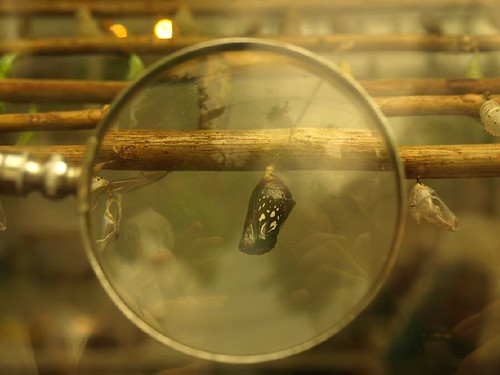I think it's safe to say that when most of us get started with yoga, we focus almost exclusively, if not entirely, on
asana practice: the physical postures of yoga. As our practice develops, however, many of us discover and incorporate more complex
pranayama, or breathing exercises. It took a whopping 10 years before I was introduced to the art of practicing pranayama. Wow, that was some rock I was hiding under! Naturally, I was well familiar with the gold standard:
ujjayi pranayama, or the victorious breath. This is the breath we take through our entire practice and is the most fundamental of pranayamas: a slow, smooth breath through a contracted glottis, making the passage of air audible. In fact, ujjayi pranayama is unique in that it may be practiced at any time of day, in any activity. I, like most yogis, was pretty much on a first-name basis with ujjayi. Ask me about any
other pranayamas, though, & I would have cocked my head to the side and given you one of those quizzical blank stares.
Nowadays, I can't fathom coming to the mat without at least practicing one other pranayama. While there are many, there is one in particular that BKS Iyengar recommends practicing everyday:
nadi shodhana: the purification, or balancing, of the nadis. Nadis are energetic pathways in the body. According to many yogic texts, there are something like 72,000 nadis in our bodies. Whoa. While this might seem like a very ethereal concept, I like to ground it in images of our circulatory and nervous systems. Imagining the body's pathways for blood, oxygen, nutrients, and electrical pulses (all constituents of and fuel for our energy) makes that idea of 72,000 nadis seem a little more down to earth.
The practice of nadi shodhana purifies the energetic pathways in the body, bringing balance and clarity to body and mind. I've actually been able to find numerous scientific studies conducted on subjects utilizing nadi shodhana. These studies have demonstrated beneficial effects on cardiopulmonary function, stress management, and higher functions of the brain, including problem solving ability. Here are links to some of these studies:
www.j-pbs.org/pdf/182/subbalakshmi.pdf
recent-science.com/article/viewFile/4627/2265
http://www.yogameditation.com/articles/issues_of_bindu/bindu_13/nadi_shodanas_influence_on_the_brain
Now that we know what nadi shodhana does, how do we practice it? I'm glad you asked:
*
Disclaimer: If at any time, feelings of anxiety, shortness of breath, or panic arise, simply return to normal breathing. Practice pranayama on an empty stomach, and only for as long as feels relaxing and appropriate. Very gradually & gently build the time spent practicing pranayama. Always consult an experienced teacher with any questions or issues that arise from practice. *
1. Sit in a comfortable seated position, where it is easy to maintain good posture (an easy cross-legged pose usually works well).
 |
| jnana mudra |
2. With the left hand, take
jnana mudra, or the mudra of wisdom. The connected thumb and index finger represent the connection between ourselves and our higher selves or the creator. The 3 extended fingers represent those things that make us forget that eternal connection: attraction, aversion, and indifference. Let the left hand rest in this mudra on the left knee.

3. The right hand is the tricky one. Bring the index finger and middle finger to touch the palm just below the base of the thumb. This separates the ring and pinky fingers. Then, bring the tip of the thumb to touch the tips of the ring and pinky fingers, bringing the latter 2 to touch each other. This is the mudra with which we control the breath in nadi shodhana.
4. Next, bring the right hand to the face. Separate the thumb from the ring and pinky fingers, placing the thumb on the side of the right nostril and the ring and pinky fingers on the side of the left nostril. Hold the hand here very lightly and easily, without using much pressure. To practice the breath, one nostril at a time is closed. To close a nostril, gently press it closed with the finger(s) that is touching it, rather than using any force to close it. The practice should be very soft & relaxing.
5. To begin, breathe a few rounds of simple ujjayi pranayama through both open nostrils. With the glottis slightly contracted, breathe slow, smooth, even inhalations followed by slow, smooth, even exhalations. Continue this quality of breath throughout nadi shodhana, even as we alternate closing one nostril at a time. So rather than beginning to suck air in and force air out through the nostril that is open, we simply continue ujjayi pranayama, but one nostril at a time will happen to be closed.
6. Now we begin nadi shodhana:
a. Press the left nostril closed, inhale through the right.
b. Press the right nostril closed, exhale through the left.
c. Inhale through the left.
d. Press the left nostril closed, exhale through the right.
e. Inhale through the right.
f. Press the right nostril closed exhale through the left.
Continue in this pattern for as many rounds as feels comfortable. Complete the exercise on an exhalation through the right nostril. Then, let the right hand rest on the right knee in
jnana mudra. Breathe freely through the nose. As we become more comfortable with the practice, we can gradually begin to incorporate
kumbhakas, or a retention/pause of the breath, between each inhalation and exhalation.
 |
| Pranayama should make us feel this relaxed! |
Nadi shodhana pranayama can be practiced at the beginning or at the end of asana practice, just before
savasana. I've experienced great benefit adding it as a staple in my daily practice. I hope you will, too. Until next time, yogis & yoginis:
NAMASTE!














